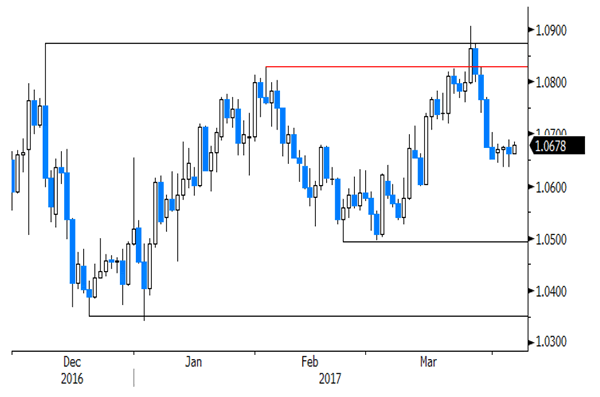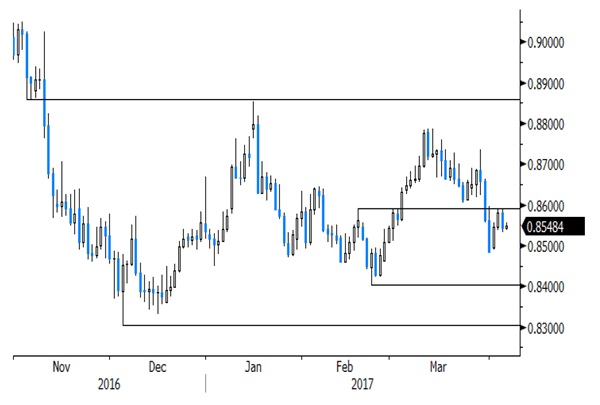Sunrise Market Commentary
Rates: FOMC’ warning on equity valuations triggers risk aversion
FOMC Minutes showed that a sudden stop or tapering of reinvestments of maturing assets on the Fed’s balance sheet could already stop at the end of 2017. US Treasuries gained ground despite this hawkish shift, profiting from safe haven flows as stocks fell prey to profit taking because of a reference to “quite high” prices in those some Minutes.
Currencies: Dollar declines as Fed Minutes trigger risk-off correction
Yesterday evening, the dollar reversed earlier gains after the Fed Minutes. The Fed signaled that more policy normalization is likely. However, it didn’t help the dollar as some members warned on equity valuation, pushing USD/JPY back towards the recent lows. However, at some point, the prospect of tighter US monetary conditions should support the dollar
The Sunrise Headlines
- US equities had a late-day change of hearts after FOMC Minutes showed that some members thought that equity prices were “quite high” relative to standard valuation measures. Overnight, Asian stocks lose ground as well.
- March FOMC Minutes showed that the Fed would likely begin shrinking a $4.5T portfolio of Treasury and mortgage securities later this year, though they remained undecided on how quickly to reduce the holdings and to what level.
- An independent gauge of China’s services sector (Caixin PMI) declined from 52.6 to 52.1 and diverged further from its official counterpart in March, suggesting growth at smaller and private firms slowed markedly in the first quarter.
- Theresa May has begun to dismantle roadblocks to a Brexit deal, including accepting the possible extension of free movement, as the European Parliament agreed to open the way to a potential “association agreement”.
- US House of Representatives Speaker Ryan said that tax reform will take longer to accomplish than repealing and replacing Obamacare would, saying Congress and the White House were initially closer to agreement on healthcare legislation than on tax policy.
- Oil prices fell as record US crude inventories underscored that crude markets remain bloated, despite efforts led by OPEC to cut output and prop up prices. Brent crude declined from $55/barrel to $54/barrel.
- Today’s eco calendar is rather uninspiring with only weekly jobless claims and ECB Minutes. Spain and France tap the market while several ECB and Fed members are scheduled to speak
Currencies: Dollar Declines As Fed Minutes Trigger Risk-Off Correction
USD declines as Fed signals policy normalization
The dollar (especially USD/JPY) initially profited from a strong ADP labour report yesterday. This move was reversed after the FOMC Minutes. Most Fed members anticipated that gradual rate increases would continue and that a change in the reinvestment policy would be appropriate later this year. Some members also considered equity valuations as “quite high”. US bond yields and the dollar declined after the Minutes. Risk-off sentiment weighed. Markets apparently also assume that a shrinking of the balance sheet could lead to slower Fed rate hikes. USD/JPY reversed early gains to finish the session at 110.70. EUR/USD touched a miner intraday low at the time of the publication, but rebounded to close the session at 1.0663.
Overnight, WS risk off sentiment also affected Asian markets. Most indices show losses of 0.5%/1.0% , with China outperforming and Japan underperforming. The Chinese Caixin PMI’s eased slightly in March (low 52 area). USD/JPY retested this week’s lows (110.30), but no break occurred yet (currently 110.45 area). EUR/USD holds in the 1.0675 area. Risk aversion also weighed on the Aussie dollar. AUD/USD dropped to the 0.7535 area, even as the dollar is under pressure across the board. Selling in the likes of AUD/JPY probably weighs.
Today, the eco calendar is thin. US weekly jobless claims have gone up in past weeks. For the latest week a drop to 250 000 from 258 000 is expected. We don’t expect much market reaction on the eve of the publication of the US payrolls. ECB speakers include Draghi, Praet (2X), Weidmann and Constancio (2X). Fed Williams speaks, too. The ECB publishes the Minutes of its March meeting. Given the controversy about the interpretation of the communication after the meeting, the ECB minutes might be more interesting than usual.
Last week, the dollar correction slowed on decent US eco data and as Fed speakers confirmed further policy normalization in 2017. At the same time, the euro lost momentum as speculation on an early ECB policy normalization eased. However, the dollar rebound had no strong legs as US yields remain relatively low near key support levels. Yesterday’s data and the Fed Minutes didn’t help the dollar. The Fed’s warning on equity valuations was a US negative. At the same time, the Fed repeated its firm intention to continue policy normalization both by raising the policy rate and by shrinking the balance sheet. The (FX) market apparently anticipates that reducing the balance sheet might slow the pace of Fed rate hikes. Both measures could go hand in hand if the US economy remains on track. In any case, further down the road, US monetary policy conditions will mostly be tightened which should be USD supportive.
Question is where the USD correction will stop. In a day-to-day perspective, a negative risk sentiment might still push US yields a few bps lower with a test of 2.3% support in the US 10-yr yield. As we assume that this level will hold, we also look for a bottoming out process of the dollar. From a technical point of view, USD/JPY last week failed to regain the 111.36/60 previous range bottom. A decline below 110 would signal more trouble ahead. We remain cautious on USD/JPY ST and first want a clear sign that a solid bottom is in place. EUR/USD extensively tested the topside of the MT range, but the test was rejected last week. The 1.0874/1.0906 area now looks a solid resistance. EUR/USD might return lower in the previous 1.0875/1.05 trading range.

EUR/USD: correction slows as USD rebound fails to gain traction
EUR/GBP
Sterling holds near the recent highs
Yesterday, the UK services PMI was the key driver for sterling trading. The January and February PMI’s showed a loss of momentum in UK services’ growth (Feb 53.3). However, the March measure surprised again on the upside and printed at a solid 55.00. Sterling jumped higher upon the publication of the report. EUR/GBP dropped from the 0.8585 area to the mid 0.85 area. In a similar way, cable jumped from the 1.2440 area to the 1.2480 area. After this reset, both EUR/GBP and cable settled again in very tight intraday ranges. EUR/GBP closed the session at 0.8542. Cable closed the session at 1.2483 supported by post-Fed USD softness
Later today, there are no important eco data on the agenda in the UK. The political bickering between the UK and the EU on the start of the Brexit negotiations continues. However, for now there is no big impact on sterling. A slightly risk-off sentiment is most often a (slightly) negative for sterling. However, with the dollar trading soft, the impact might also remain modest. So, a calm order driven session can be expected for sterling trading. Mid-March, sterling found a better bid after higher than expected UK inflation and a more hawkish tone from the BoE. We changed our short-term bias on EUR/GBP from positive to neutral. The EUR/GBP 0.88/0.84 range should guide EUR/GBP trading medium term. Since late last week, the sterling rally/short-squeeze shows tentative signs of running into resistance, but we see no trigger for a real change in sentiment yet. Longer term, Brexit-complications remain a potential negative for sterling. We are not convinced that the BoE will raise rates anytime soon, even not after recent higher inflation data

EUR/GBP sterling short-squeeze is easing, but no sustained sterling correction yet











